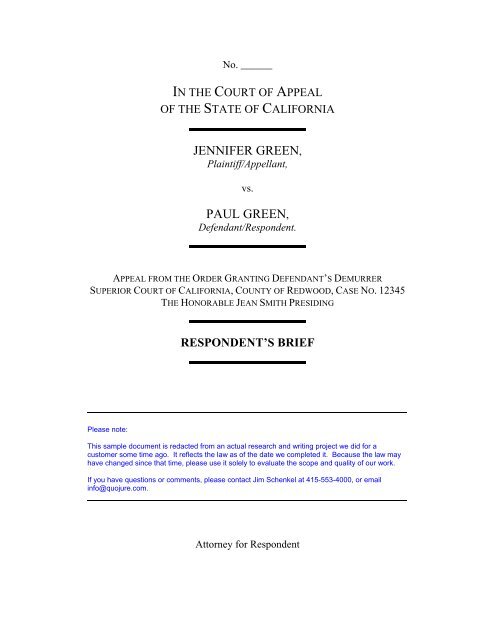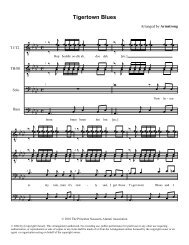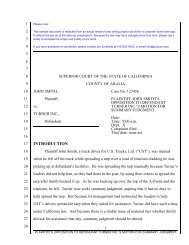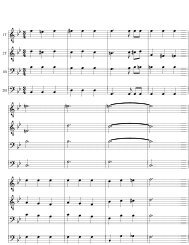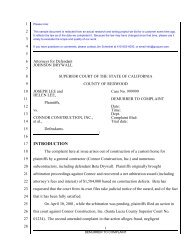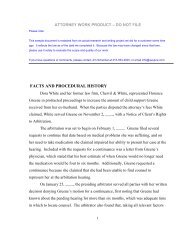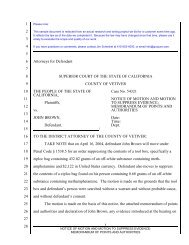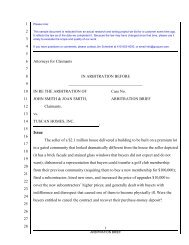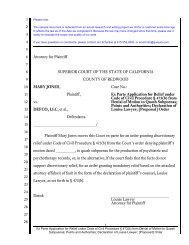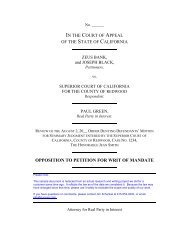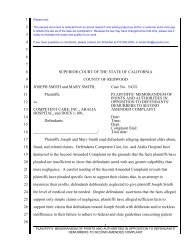Respondent's brief - Quo Jure Corporation
Respondent's brief - Quo Jure Corporation
Respondent's brief - Quo Jure Corporation
Create successful ePaper yourself
Turn your PDF publications into a flip-book with our unique Google optimized e-Paper software.
No. ______<br />
IN THE COURT OF APPEAL<br />
OF THE STATE OF CALIFORNIA<br />
JENNIFER GREEN,<br />
Plaintiff/Appellant,<br />
vs.<br />
PAUL GREEN,<br />
Defendant/Respondent.<br />
APPEAL FROM THE ORDER GRANTING DEFENDANT’S DEMURRER<br />
SUPERIOR COURT OF CALIFORNIA, COUNTY OF REDWOOD, CASE NO. 12345<br />
THE HONORABLE JEAN SMITH PRESIDING<br />
Please note:<br />
RESPONDENT’S BRIEF<br />
This sample document is redacted from an actual research and writing project we did for a<br />
customer some time ago. It reflects the law as of the date we completed it. Because the law may<br />
have changed since that time, please use it solely to evaluate the scope and quality of our work.<br />
If you have questions or comments, please contact Jim Schenkel at 415-553-4000, or email<br />
info@quojure.com.<br />
Attorney for Respondent
CERTIFICATE OF INTERESTED ENTITIES OR PERSONS<br />
California Rules of Court, Rule 14.5<br />
No other person or entity has a financial or other interest in the<br />
outcome of this proceeding.<br />
I declare under penalty of perjury under California law that the<br />
foregoing is true and correct.<br />
Dated:<br />
Attorney for Respondent
TABLE OF CONTENTS<br />
ARGUMENT................................................1<br />
1. Standard of review ......................................1<br />
2. Res judicata bars appellant’s complaint.......................1<br />
A. The complaint is barred by claim preclusion. ............2<br />
B. The complaint is barred by issue preclusion..............6<br />
(1) The issues in the Family Law Motion are identical to<br />
the issues raised in Jennifer’s complaint. ..........6<br />
(2) The issues in the complaint were actually litigated in<br />
the Family Law Motion. .......................7<br />
(3) The issues raised in the Notice of Motion were<br />
necessarily decided in Family Law Action. ........8<br />
(4) The Stipulated Order was a final judgment on the<br />
merits. .....................................9<br />
(5) Paul seeks issue preclusion against a party to the<br />
Family Law Motion...........................9<br />
3. The Family Law Court has exclusive jurisdiction over the<br />
action. ...............................................11<br />
CONCLUSION .............................................12<br />
i
CASES<br />
TABLE OF AUTHORITIES<br />
Askew v. Askew (1994) 22 Cal.App.4th 942 ....................11, 12<br />
Barker v. Hull (1987) 191 Cal.App.3d 236 .........................7<br />
Beck v. American Health Group Internat., Inc. (1989) 211 Cal.App.3d 1555<br />
............................................................1<br />
Brosterhous v. State Bar (1995) 12 Cal.4th 315 .....................2<br />
California State Auto Assn. Inter-Ins. Bureau v. Superior Court (1990) 50<br />
Cal.3d 658 ..................................................3<br />
CAMSI IV v. Hunter Tech. Corp. (1991) 230 Cal.App.3d 1525 .........1<br />
Craig v. County of Los Angeles (1990) 221 Cal.App.3d 1294 ........2, 4<br />
Flynn v. Gorton (1989) 207 Cal.App.3d 1550 ...................1, 2, 9<br />
Frommhagen v. Bd. of Supervisors (1987) 197 Cal.App.3d 1292 ........6<br />
In Re Marriage of Buckley (1982) 133 Cal.App.3d 927 .......... 3, 8-10<br />
In Re Marriage of McNeill (1984) 160 Cal.App.3d 548 ............5, 11<br />
Landeros v. Pankey (1995) 39 Cal.App.4th 1167 ....................8<br />
Lucido v. Superior Court (1990) 51 Cal.3d 335 .................1, 6, 8<br />
Marriage of Schenk (1991) 228 Cal.App.3d 1474 ...................11<br />
Mattson v. City of Costa Mesa (1980) 106 Cal.App.3d 441 ..........2, 5<br />
Rogers v. Austin (1979) 94 Cal.App.3d 918 ......................3, 4<br />
Slater v. Blackwood (1975) 15 Cal.3d 791 .........................2<br />
State Farm Mut. Auto.Ins. Assoc. v. Superior Court (1989) 211 Cal.App.3d<br />
ii
5 ..........................................................7<br />
Takahashi v. Board of Education (1988) 202 Cal.App.3d 1464 .........5<br />
Trustees of Capital Wholesale Electric Etc. Fund v. Shearson Lehman<br />
Brothers, Inc. (1990) 221 Cal.App.3d 617 .........................1<br />
STATUTES<br />
California Rule of Court 1212 ................................5, 10<br />
Civil Code §43.4 ............................................10<br />
Code of Civil Procedure §1911 ..................................8<br />
Code of Civil Procedure §430.30(a) ..............................2<br />
OTHER AUTHORITY<br />
RESTATEMENT, SECOND, JUDGMENTS §24, comment g ................5<br />
iii
ARGUMENT<br />
1. Standard of review<br />
The standard of review in this case is whether the trial court abused<br />
its discretion in sustaining respondent’s demurrer without leave to amend.<br />
CAMSI IV v. Hunter Tech. Corp. (1991) 230 Cal.App.3d 1525, 1538. The<br />
judgment must be affirmed if any one of the grounds for the demurrer is<br />
well taken. Beck v. American Health Group Internat., Inc. (1989) 211<br />
Cal.App.3d 1555, 1566. It is the validity of the trial court’s action in<br />
sustaining the demurrer that is reviewable, not the court’s statement of<br />
reasons for its action. Ibid. On appeal, the plaintiff has the burden of<br />
showing how the trial court abused its discretion in sustaining the demurrer.<br />
Trustees of Capital Wholesale Electric Etc. Fund v. Shearson Lehman<br />
Brothers, Inc. (1990) 221 Cal.App.3d 617, 627.<br />
2. Res judicata bars appellant’s complaint.<br />
The doctrine of res judicata is composed of two parts: claim<br />
preclusion and issue preclusion. Claim preclusion prohibits a party from<br />
relitigating a previously adjudicated cause of action. A new lawsuit on the<br />
same cause of action is entirely barred. Issue preclusion, also known as<br />
“collateral estoppel,” applies to a later suit between the parties on a<br />
different cause of action. Collateral estoppel prevents the parties from re-<br />
litigating any issue actually litigated and finally decided in the earlier<br />
action. Lucido v. Superior Court (1990) 51 Cal.3d 335, 341, fn 3; Flynn v.<br />
Gorton (1989) 207 Cal.App.3d 1550, 1554.<br />
Both aspects of res judicata share the common goals of preventing<br />
inconsistent results, and promoting finality and judicial economy by<br />
1
inging an end to litigation. Ibid. The defense of res judicata is<br />
appropriately raised by demurrer if the grounds for asserting the defense<br />
appear on the face of the complaint or from matters that can be judicially<br />
noticed. Brosterhous v. State Bar (1995) 12 Cal.4th 315, 324; Code Civ.<br />
Proc. § 430.30(a).<br />
Here, appellant/plaintiff Jennifer Green’s complaint is absolutely<br />
barred under either or both aspects of res judicata.<br />
A. The complaint is barred by claim preclusion.<br />
Claim preclusion bars a second lawsuit between the same parties on<br />
the same cause of action. Flynn v. Gorton, supra; Slater v. Blackwood<br />
(1975) 15 Cal.3d 791, 795. The earlier cause of action merges into the<br />
judgment, which prohibits a plaintiff from splitting a cause of action into<br />
successive lawsuits. Craig v. County of Los Angeles (1990) 221<br />
Cal.App.3d 1294, 1301.<br />
California courts employ the “primary rights” theory in determining<br />
what constitutes a cause of action and whether the earlier lawsuit involved<br />
the same cause of action as the one in the later suit. Slater, supra; Craig,<br />
supra. The violation of one primary right gives rise to a single cause of<br />
action. Slater, supra, at 795. “Under this theory, the underlying right<br />
sought to be enforced determines the cause of action. In determining the<br />
primary right, the significant factor is the harm suffered.” Craig, supra, at<br />
1301.<br />
Under claim preclusion, the prior final judgment on the merits not<br />
only settles all the issues actually litigated in the first action but also every<br />
issue that could have been raised and litigated as well. Mattson v. City of<br />
Costa Mesa (1980) 106 Cal.App.3d 441, 446. Thus, claim preclusion bars<br />
2
litigation of the same cause of action on a different legal theory or for<br />
different relief. Ibid.<br />
For purposes of applying claim preclusion, a stipulated judgment or<br />
order is a judgment on the merits and conclusively determines all matters<br />
put into the pleadings, unless the parties agree to restrict its scope by<br />
expressly withdrawing an issue from the stipulated judgment or order.<br />
California State Auto Assn. Inter-Ins. Bureau v. Superior Court (1990) 50<br />
Cal.3d 658; In Re Marriage of Buckley (1982) 133 Cal.App.3d 927.<br />
Applying the primary-rights theory here compels the conclusion that<br />
Jennifer’s family law notice of motion and her complaint in the later civil<br />
action involve the same cause of action, and thus her complaint is barred by<br />
claim preclusion. Both actions seek to redress the same harm Jennifer<br />
allegedly suffered as a result of respondent Paul Green’s sale of the family<br />
residence without her knowledge and his later failure to turn over her share<br />
of the sale proceeds. No matter how cleverly Jennifer characterizes it, that<br />
harm is simply the alleged denial of her right to share in the community<br />
property from the parties’ marriage.<br />
The stipulated order the parties entered into provides for Paul to<br />
make equalization payments of $27,500 to redress this harm. Jennifer’s<br />
complaint essentially seeks to recover for the same harm, only under such<br />
different legal theories as breach of contract and fraud. But her use of<br />
different legal theories and her desire for different remedies in her civil<br />
action does not avoid the application of claim preclusion and will not skirt<br />
its bar of the later civil action.<br />
In Rogers v. Austin (1979) 94 Cal.App.3d 918, husband and wife<br />
entered into a stipulated judgment regarding the division of marital<br />
property. Husband later attempted to set aside the property division in the<br />
3
family law court on the grounds of fraud. That court upheld the earlier<br />
property division. Husband then sued wife for fraud, again seeking to<br />
disturb the earlier property division. The court held that the civil action was<br />
barred under claim preclusion. Id. at 920.<br />
Here, Jennifer’s complaint attempts to re-litigate Paul’s alleged<br />
denial of her right to a share of the family law property division, but the<br />
family law court already addressed and rectified that denial. As in Rogers,<br />
the family-law stipulated order and judgment in this case cannot be<br />
relitigated and disturbed in a civil action.<br />
Jennifer’s reliance on Craig v. County of Los Angeles, supra, 221<br />
Cal.App.3d 1294, is misplaced. She offers no reasoned analysis why that<br />
case supports her position. Craig is readily distinguishable. The plaintiff<br />
sought to redress two distinct harms in the two actions. In a mandate<br />
proceeding, the plaintiff sought only to assert his right to be employed as a<br />
harbor police officer. His second action involved his right to past salary<br />
and damages, resulting from the defendant’s conduct denying his right to<br />
employment. Here, in contrast, Jennifer asserted in the family law motion<br />
both her right to share in the community property and the amount to which<br />
she was entitled by virtue of that right.<br />
Despite Jennifer’s long-winded analysis of Pomeroy’s theory of<br />
primary rights, she never applies the theory here; instead, she relies on the<br />
simple formal aspect of her pleadings. Her argument comes down to:<br />
Plaintiff/Appellant argues that the Stipulation and Order<br />
authorizing equalization payments . . . involved a<br />
different primary right than those asserted in these causes<br />
of action. The issue of breach of contract, fraud or<br />
conversion was not considered in the dissolution<br />
proceeding.<br />
Appellant’s Opening Brief, 21:21-26.<br />
4
This assertion is made in vain because claim preclusion bars litigation of the<br />
same cause of action on a different legal theory or for different relief.<br />
Mattson, supra, 106 Cal. App.3d at 446.<br />
Jennifer also argues that she could not assert these theories in family<br />
law court because of California Rule of Court 1212; thus, she asserts, claim<br />
preclusion should not apply. This argument is flawed for two reasons.<br />
First, Rule 1212 does not prohibit a party in a family law proceeding from<br />
filing a civil action for relief or on theories not authorized by the Family<br />
Code. Jennifer could have filed the instant action simultaneously with the<br />
filing of the notice of motion and had the two actions consolidated.<br />
Marriage of McNeill (1984) 160 Cal.App.3d 548, 557.<br />
Second, Jennifer chose unilaterally to proceed in the family law<br />
court. No one compelled her to do so. She cannot now avoid the bar of<br />
claim preclusion by arguing that the family law court was statutorily barred<br />
from granting all the relief to which she claims she is entitled. Mattson,<br />
supra, at 449-450; RESTATEMENT, SECOND, JUDGMENTS § 24, comment g.<br />
This rule applies even if the plaintiff seeks additional consequential<br />
damages or punitive damages in the second action, neither of which could<br />
have been awarded in the first action. Takahashi v. Board of Education<br />
(1988) 202 Cal.App.3d 1464, 1476. Again, the fundamental question is<br />
whether those additional consequential damages flow from an infringement<br />
of a separate and distinct primary right. Ibid. Here the answer is a<br />
resounding “No.” Jennifer’s request for additional consequential damages<br />
arises out of the invasion of the same primary right.<br />
B. The complaint is barred by issue preclusion.<br />
Even if the claim preclusion aspect of res judicata were not a bar to<br />
5
Jennifer’s action, the issue preclusion aspect unequivocally does bar it. The<br />
five requirements for issue preclusion are present here: the issues in the two<br />
actions are identical, the issues were actually litigated in the prior action,<br />
the issues were necessarily decided in the prior action, the decision in the<br />
prior action was on the merits and is final, and the party against whom<br />
preclusion is sought is the same as, or in privity with, the party in the prior<br />
action. Lucido v. Superior Court, supra, 51 Cal.3d 335, 341.<br />
(1) The issues in the Family Law Motion are identical to the issues<br />
raised in Jennifer’s complaint.<br />
“The ‘identical issue’ requirement addresses whether ‘identical<br />
factual allegations’ are at stake in the two proceedings, not whether the<br />
ultimate issues or dispositions are the same.” Id. at 342. To determine<br />
whether the same factual allegations are at stake in both proceedings, the<br />
trial court can examine the prior suit’s entire record. Frommhagen v. Bd. of<br />
Supervisors (1987) 197 Cal.App.3d 1292, 1301, fn.3.<br />
If Jennifer’s Family Law Notice of Motion, including her declaration<br />
and request for relief, is juxtaposed with her civil complaint, a careful<br />
analysis reveals that they both present the identical factual allegations.<br />
Jennifer’s complaint indisputably arises out of the same nexus of facts<br />
complained of in the Notice of Motion: that Paul breached an agreement to<br />
provide her share of the community property through the sale of the family<br />
residence; that Paul sold the family residence without her knowledge; and<br />
that he then kept the proceeds for himself without providing for Jennifer’s<br />
community property share. Under Lucido, the identical-issue requirement is<br />
easily met.<br />
Jennifer attempts to confuse this court by arguing that the Family<br />
6
Law Notice of Motion did not address the same “cause of action.” AOB,<br />
24:18-20. But this is irrelevant to the issue-preclusion analysis and has no<br />
bearing on whether the two cases have identical issues. Jennifer then<br />
argues:<br />
The Stipulation and Order on Order To Show Cause . . .<br />
addressed the issue of the equalization installment<br />
payments . . . . On the other hand, the underlying civil<br />
action relates to Defendant/Respondent’s conscious<br />
disregard of Plaintiff/Appellant’s property rights by using<br />
the escrow proceeds from the sale of the family residence<br />
for his own personal gain . . . .<br />
AOB 24:20-27.<br />
Jennifer argues that different legal issues were at stake in the two actions,<br />
but this is irrelevant under Lucido: the first requirement is met if the factual<br />
allegations are the same.<br />
(2) The issues in the complaint were actually litigated in the Family<br />
Law Motion.<br />
For issue preclusion to apply, the issues sought to be barred must<br />
have been actually litigated in the prior action. An issue is “actually<br />
litigated” if: (i) it is properly raised by the pleadings; (ii) submitted for<br />
determination; and (iii) finally determined. Barker v. Hull (1987) 191<br />
Cal.App.3d 221, 225-227. No particular level of litigation activity is<br />
necessary to satisfy this requirement. State Farm Mut. Auto.Ins. Assoc. v.<br />
Superior Court (1989) 211 Cal.App.3d 5, 15, fn.12. The party asserting<br />
issue preclusion need not show that any particular evidence was presented<br />
at the earlier action. Ibid.<br />
It is well settled that an action ending in a stipulated judgment or<br />
order satisfies the requirement that the issues be actually litigated.<br />
7
Marriage of Buckley, supra, 133 Cal.App.3d at 935; Landeros v. Pankey<br />
(1995) 39 Cal.App.4th 1167, 1173. This is true so long as the parties do not<br />
expressly reserve or withdraw an issue in the pleadings from the scope of<br />
the stipulation. Buckley, supra, at 935. Here, the identical factual issues in<br />
Jennifer’s complaint were pleaded in the Family Law Notice of Motion and<br />
she had an opportunity to pursue her claims in the first action. Further,<br />
none of these issues raised by the Family Law pleadings were expressly<br />
excluded or reserved by the Family Law Stipulation and Order.<br />
(3) The issues raised in the Notice of Motion were necessarily decided<br />
in Family Law Action.<br />
This requirement is met if the issue(s) were not “entirely<br />
unnecessary” to the judgment in the prior action. Lucido, at 342. “That<br />
only is deemed to have been adjudged in a former judgment which appears<br />
upon its face to have been so adjudged, or which was actually and<br />
necessarily included therein or necessary thereto.” Code Civ. Proc. § 1911.<br />
Paragraph 10 of the Family Law Stipulation states: “Respondent<br />
acknowledges that he owes Petitioner $27,500. . . .” Clerk’s Transcript, at<br />
37. Thus the issues Jennifer raised in her Notice of Motion—that she was<br />
entitled to her community property share, and that Paul wrongfully withheld<br />
her share from the sale of the family residence—were resolved and included<br />
in the Stipulation. Looked at another way, the parties necessarily<br />
determined that Paul owed Jennifer $27,500 to provide for her community<br />
share in the marriage and, therefore, Paul was not entitled to keep the entire<br />
amount of the proceeds of the sale of the family home.<br />
Additionally, the stipulation does not expressly exclude or reserve<br />
any issues raised by the family law notice of motion.<br />
8
(4) The Stipulated Order was a final judgment on the merits.<br />
A stipulated judgment or order is a judgment on the merits for<br />
purposes of applying issue preclusion. Marriage of Buckley, supra, 133<br />
Cal.App.3d at 935.<br />
(5) Paul seeks issue preclusion against a party to the Family Law<br />
Motion.<br />
Jennifer concedes that this requirement is met. A.B. 27:23-26. She<br />
was obviously a party to both actions.<br />
In sum, the five requirements for the application of issue preclusion<br />
are present and bar Jennifer’s complaint. She offers no compelling reasons<br />
why the application of issue preclusion here would not further the court’s<br />
underlying policies of judicial economy and finality of actions. Flynn,<br />
supra.<br />
Jennifer had her day in court in the Family Law Division and had an<br />
opportunity to assert her right to share in the marriage’s community<br />
property. Indeed, Paul ultimately acknowledged her right and stipulated to<br />
an order against himself in the amount of $27,500. That Jennifer may now<br />
not be happy with the amount she exacted from Paul in the family law<br />
action does not warrant disregarding the principles of res judicata. If her<br />
action were successful, it would open the door for disgruntled spouses to<br />
file civil actions, alleging fraud and the like, seeking to set aside community<br />
property distributions made in the Family Law Court with which they were<br />
dissatisfied.<br />
Moreover, California Rule of Court, Rule 1212's prohibition against<br />
pleading certain causes of action or claims for relief is of no avail. In<br />
Buckley, the husband attempted to argue the same thing. The court<br />
9
esponded:<br />
[T]he fact that husband could not have responded to<br />
wife’s dissolution action with a tort cross-complaint is<br />
irrelevant. The doctrine of collateral estoppel is a doctrine<br />
of “issue preclusion.” [Citation.] The issue of wife’s<br />
alleged fraud was necessarily determined by the consent<br />
judgment, and husband cannot now vex and harass wife<br />
by litigating that issue again in a new cause of action.<br />
Id. at 936.<br />
Jennifer’s attempt to distinguish Buckley is unpersuasive. The nature and<br />
timing of the fraud the husband complained of was irrelevant to the Buckley<br />
court’s consideration of issue preclusion. Before the court began its<br />
discussion of issue preclusion it observed:<br />
[E]ven if husband’s action was not barred by Civil Code<br />
Section 43.4, or if his complaint can be read as an attempt<br />
to state a cause of action for the restoration of money<br />
obtained by fraud, the trial court properly granted<br />
judgement for wife, as husband was also collaterally<br />
estopped by the stipulated judgement of nullity from<br />
relitigating the issue of wife’s alleged fraud.<br />
Buckley, at 934.<br />
Here, Jennifer’s complaint is also akin to an action for the restoration of<br />
money obtained by fraud, and admittedly not like an action for a broken<br />
promise to marry. But such distinction is irrelevant to the court’s issue<br />
preclusion analysis, since it assumed for the sake of its discussion that Civil<br />
Code § 43.4 did not barr the husband’s action. Thus Jennifer’s argument—<br />
that Marriage of McNeill, supra, is “controlling” because the nature and<br />
timing of the fraud is more like that alleged in her complaint—is pointless.<br />
10
3. The Family Law Court has exclusive jurisdiction over the<br />
action.<br />
The Family Law Court’s exclusive jurisdiction over the parties and<br />
subject matter supports the trial court’s order sustaining the demurrer<br />
without leave to amend. After a family law court acquires jurisdiction in a<br />
marriage dissolution action to characterize, value, and divide the parties’<br />
community property, no other department may entertain proceedings or<br />
make an order adversely affecting the family court’s property jurisdiction.<br />
Askew v. Askew (1994) 22 Cal.App.4th 942, 961. This rule obtains even if<br />
the family law court has entered judgment in the marital action, so long as<br />
the court has reserved jurisdiction. Marriage of Schenk (1991) 228<br />
Cal.App.3d 1474, 1483-1484. 1<br />
Because Jennifer’s civil action implicates the issue of the parties’<br />
community rights in the family residence, Askew controls and prevents the<br />
trial court from exercising jurisdiction over Jennifer’s action. Any ruling<br />
the civil court made on her civil action would affect and interfere with the<br />
family law court’s original ruling on the appropriate distribution of the<br />
proceeds from the sale of the family residence and its continuing<br />
jurisdiction over the parties and subject matter. The court in the civil action<br />
may not make any such order or judgment. Askew at 961.<br />
1 McNeill stands for nothing more than the proposition that a family<br />
law court may consolidate a family law action with an independent civil<br />
action raising common issues of law and fact. McNeill, supra, 160<br />
Cal.App.3d at 556-557. But this is not helpful to Jennifer, since she failed<br />
to file the civil action at the same time she brought the Family Law Notice<br />
of Motion and then move for consolidation before the Family Law Motion<br />
was resolved. Thus, any civil action brought now is barred by res judicata.<br />
McNeill does not dictate a contrary result.<br />
11
CONCLUSION<br />
Jennifer has failed to carry her burden of showing that the trial<br />
court’s granting the demurrer without leave to amend was an abuse of<br />
discretion. The complaint is barred under either or both aspects of res<br />
judicata and on the grounds that the Family Law court has exclusive<br />
jurisdiction over the property division issues arising out of the marriage.<br />
The trial’s court ruling should be upheld.<br />
Dated: Respectfully submitted,<br />
12<br />
Attorneys for Respondent


